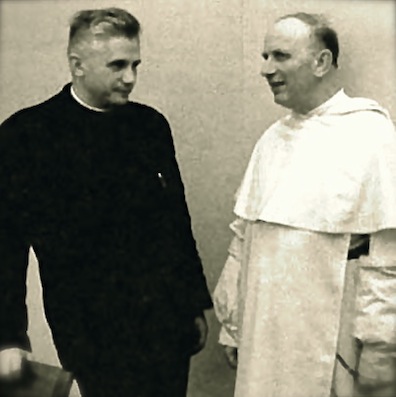During Richard Nixon’s 1971 visit to China, Chinese premier Zhou Enlai was asked what he thought about the French Revolution (1789). He reportedly said: “It is too soon to say.”
Many thought this an amusing expression of millennial, oriental perspectives – though several China experts say the interpreter badly flubbed things and Zhou (a tough modern Communist, after all, not a Confucian scholar) was referring to recent student rebellions in Paris (1968).
Some Catholic commentators have tried to hedge their views on the Second Vatican Council (1962-5) with a similar caveat. In the long perspectives of the Church, they say, it’s too soon to say what it will ultimately mean.
This past Friday, the Church “celebrated” the fiftieth anniversary of the opening of the Council and opened the Year of Faith, even as it had just been engaged in a Synod on the New Evangelization – a New Evangelization necessitated, in part, by some of the negative consequences of the Council.
A half-century into the mission, it’s clear that the long-term argument is a distraction. The Council’s primary importance, for good and bad – and there was a lot of both – was what it did during the last third of the twentieth century.
The long-term impact will depend on what present and future Catholics do with the Council – hence the Synod and other measures.
In many ways, the search for the True Meaning of Vatican II is a lot like the “search for the historical Jesus.” Much depends on the assumptions, especially the unconscious ones, you bring to the task, which cannot be carried out with merely historical or analytical methods anyway.
The texts, important as they are, notably fail to convince people who think that the “spirit,” not the letter, is the Council’s real meaning. John Paul II already had to convene a Synod of Bishops in 1985, which declared that spirit and letter should not be set against each other, and that Vatican II had to be interpreted in continuity with tradition and the earlier councils.
But you’d have to be virtually brain dead not to know that, almost thirty years later, these are still very live issues in the Church. In the state of Washington at the moment, sixty-three ex-priests are publicly opposing the Church’s attempt to stop the legalization of gay marriage with a classic post-conciliar argument: it violates Jesus’ welcoming embrace of all.
For many Catholics, here and around the world, the main effect of the Council is still to have reduced Christianity to this sort of simplistic monomania.
I was in Rome last week and there was a lot of enthusiasm about the New Evangelization, as there should be, but also much unacknowledged nervousness. The bishops at the synod said some incisive and, occasionally, profound things. But talk is easy. Action, in our circumstances, much harder. And only vigorous action will bring the legacy of the Council into a different course.

The great theologian Henri de Lubac, S.J., one of the inspirations of the Council, warned after the event, “The Yes said wholeheartedly to the Council and to all its legitimate consequences must, in order to remain consistent and sincere, be coupled with a No that is just as resolute to a certain type of exploitation that is, in fact, a perversion of it.”
La nouvelle théologie brought a lot to the Church. Not only de Lubac, but Congar, Chenu, Daniélou, Boyer, von Balthasar, and others discovered something really valuable in the tradition.
It was no small thing that, at the height of its powers in the twentieth century, the Roman Catholic Church in solemn synod put forward the universal call for holiness, an increased emphasis on the role of the laity in the world, and the vision for a more pastoral and communitarian Church, rather than a juridical one.
And all of it – as Pope John XXIII intended in convening the Council – was to supplement settled Catholic theological and moral teaching and make it more effective in engaging the world. Joseph Ratzinger, a sharp observer even as a young man, remarked at the time that two early tasks of the Council were: to dispel the notion that everything was fine in the Church and to overcome an “anti-Modernist neurosis.”
The Council certainly did both. But those who warned about where the new course would take us – and who were and are often mocked as hopeless reactionaries – were right in their dire predictions.
Specifically, the recognition that the Church needed to be a less legalistic and more pastoral community led many to think that rules were per se a sign of lack of charity. But as I’ve often said, trying to be pastoral without knowing concretely what helping people means, is like being a doctor with a good bedside manner – who is ignorant of medicine.
And the Church’s “opening to the world” was often taken to mean not only that an excessive wariness about modernity was to be jettisoned, but that modernity itself was to become the standard by which to judge things in a supposedly “mature” and engaged Church.
John Paul II and Benedict XVI have cleaned up a lot of the mess, but a lot more remains, as the Synod deliberations well show. Much of the New Evangelization is aimed at formerly Christian societies
Benedict held a meeting Friday for the surviving bishops who had been participants in the Council, at which he virtually summed up the experience of the last fifty years: “The Council was a time of grace in which the Holy Spirit taught us that the Church, in her journey in history, must always speak to contemporary man, but this can only happen through the strength of those who are profoundly rooted in God, who allow themselves to be guided by Him and live their faith with purity; it does not happen with those who adapt themselves to the passing moment, those who choose the most comfortable way.”















